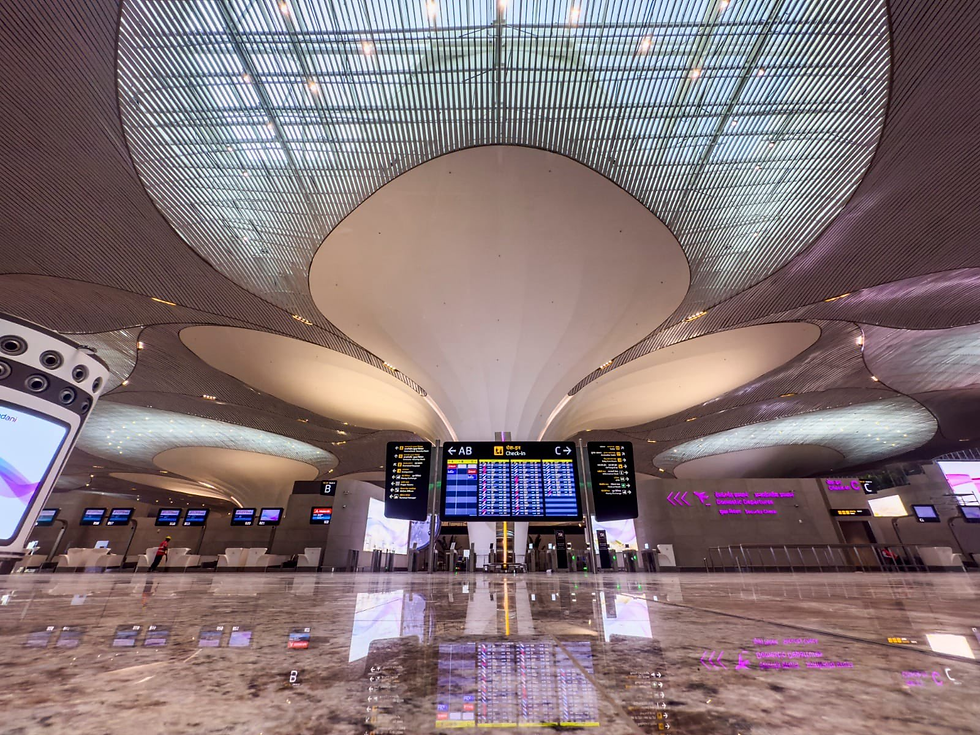A new fashion display at the Design Museum in London honours the Sari
- The Communiqué

- May 19, 2023
- 4 min read
The first large-scale exhibition in the UK examining the contemporary Indian sari has opened at the Design Museum in London.
Swati Bhat

Image: Design Museum by Andy Stagg; The Offbeat Sari exhibition
'The Offbeat Sari,' on display until September 17, has more than 60 modern saris on loan from designers and studios across India, including the first-ever sari worn at the Met Gala in 2022 and saris constructed of woven steel and frayed denim.
The exhibition, curated by Priya Khanchandani, the Design Museum's head of curatorial, puts one of the world's most recognisable items of clothing front and centre, highlighting the craftsmanship behind the contemporary Indian fashion garment, as well as the "fashion revolution" the sari is currently experiencing.
"The sari is experiencing what is conceivably its most rapid reinvention in its 5,000-year history," says Khanchandani in a statement. "It elevates the sari movement to one of today's most important global fashion stories, despite the fact that little is known about its true nature outside of South Asia." Women in cities who traditionally linked the sari with dressing up are changing it into fresh, radical, daily attire that empowers them to express who they are, while designers play with its materiality with boundless ingenuity."
Conventionally a single piece of unstitched fabric, the sari has been adapted in drape and form over millennia, explains the exhibition, to reflect identity, social class, taste and function across time and geography, and remains an enduring part of life in India today. Yet in recent decades, for many, the sari has been considered traditional or uncomfortable as a form of everyday clothing, especially by young people.
The Offbeat Sari exhibition opens at the Design Museum
However, in the past decade, the sari has been “reenergised” and elevated as a fashion item, with many designers in India experimenting with hybrid forms such as sari gowns, pre-draped saris, and innovative materials such as steel, as well as using contemporary materials such as denim.
This revolution it adds is being driven by young people in cities, who previously associated the sari with dressing up but are now wearing the versatile garment with sneakers on their commutes to work.
Khanchandani added: “For me and for so many others, the sari is of personal and cultural significance, but it is also a rich, dynamic canvas for innovation, encapsulating the vitality and eclecticism of Indian culture.
“With last month’s news that it has become the world’s most populated country, India’s significance within contemporary culture is vast, and the sari foregrounds the country’s undeniable imagination and verve, while asserting the relevance of Indian design on a global stage.”
Design Museum displays more than 60 saris
The exhibition is divided into three main sections: transformation, identity and resistance and new materialities, highlighting over 60 saris from growing global brands to emerging studios, including Abraham & Thakore, Raw Mango, Akaaro and NorBlackNorWhite, as well as Amit Aggarwal, Huemn, Diksha Khanna, Bodice, Tarun Tahilian, Abu Jani Sandeep Khosla, and Sabyasachi.
The transformation section highlights the work of the designers in India who have fuelled the experimentation of recent years, such as a sari adorned with sequins cut from disused X-ray images obtained from hospital waste and by Abraham & Thakore, a distressed denim sari by Diksha Khanna and a lacquered sari drape wrapped around a plinth in a form of conceptual play on the sari by contemporary artist Bharti Kher.
This leads into a section dedicated to how the sari is being crafted as an expression of identity and resistance, from empowering the female body to using the sari as an object of protest. Examples include the red silk sari worn by Tamil-Swiss singer-songwriter Priya Ragu, a block-print sari worn by self-proclaimed ‘Saree Man’ Himanshu Verma and the ‘Arch’ sari by Adavid styled with a shirt by Bangladeshi architect and advocate for body positivity Sobia Ameen. There are also saris worn by female demonstrators in rural India such as The Gulabi Gang and The Hargila Army as a tool for protest. There is even a section showing how young women are wearing saris to climb, play cricket, and skateboard.
The final section, new materialities, looks at the sari as a textile, showing the intricacy of sari craftsmanship from weaves, patterns, texture and colours to surface embellishment, alongside sustainable innovations and designers pushing the boundaries. This includes a golden sari by Rimzim Dadu constructed from hair-thin stainless steel wires to create a gold sculpted wave.
Other highlights from the exhibition include a copy of Tarun Tahiliani’s foil jersey sari worn by Lady Gaga, Abu Jani Sandeep Khosla’s ruffled sari worn by Bollywood star Deepika Padukone at the Cannes Film Festival in 2022, and the first-ever sari worn to the Met Gala designed by Sabyasachi, and styled with a gold Schiaparelli bodice worn by businesswoman and socialite Natasha Poornawalla.
Tim Marlow, chief executive and director at the Design Museum, added: “It’s in the Design Museum’s mission to examine the world as it is today across geographies. The Offbeat Sari highlights design’s role in a huge fashion story that’s little-known outside India, providing a site for us to reflect, with our partners and lenders in India, and the South Asian diaspora here, on the impact of India's fashion creativity.
“Indian textiles have long been explored ethnographically in international museums and we are excited to be presenting cutting-edge Indian fashion to UK audiences in London this summer.”
‘The Offbeat Sari’ at the Design Museum runs until 17 September.














Comments